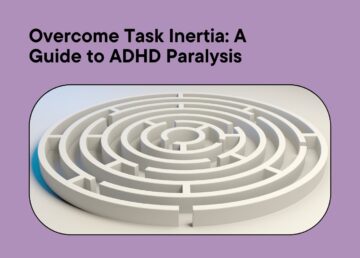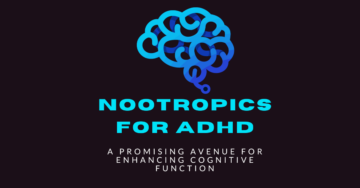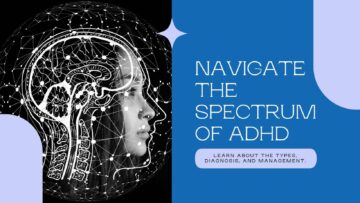
Ever felt like there’s a motor inside of you that makes you move around and do something? This is one of the ways that the ADHD hyperactive type manifests in daily life.
The hyperactive type is most often associated with children. Their immense amount of energy that seems like it’s never running out can indicate hyperactivity, but that’s usually not the case for adults.
Neurotypical people can often disregard those with ADHD hyperactive type as having excessive energy, poor manners, and little self-control, but that’s not true.
ADHD affects how a person acts, thinks, and understands the world, so knowing how the hyperactive type manifests and what can be done to ease the symptoms is vital.
What Is Hyperactive ADHD?
Attention deficit and hyperactivity disorder, or ADHD in short, is a neurodevelopmental disorder that alters how a person’s brain functions.
A person with ADHD might experience impulsiveness, forgetfulness, lack of attention, restlessness, and other symptoms. ADHD hyperactive type is usually characterized by symptoms such as:
- Fidgeting. Squirming while seated, playing with hands, feet, and hair.
- Inability to stay seated for more extended periods. Standing up and/or walking around when it is expected to remain seated. E.g., in a classroom or meetings.
- Restlessness. A person might experience a need to move or fidget. They might feel discomfort if they have to remain still for long periods.
- Excessive and loud talking. People with hyperactive ADHD might have trouble regulating the loudness of their voices and condensing information when talking.
- Difficulty waiting for their turn. The constant need to be on the go can make it arduous to wait in lines or for their turn to speak or act. This can lead to interrupting others in conversations, games, and professional settings.
- Impulsivity. People with hyperactive ADHD can make decisions on a whim without giving them a second thought.
However, while the ADHD hyperactive type is easily spotted when expressed externally, some people report feeling inner hyperactivity.
Usually, mental hyperactivity is described as racing thoughts, having several thought trains at once, and difficulty in quieting the mind. Hence, people with ADHD might have trouble staying focused, relaxing, and falling asleep.
Types of ADHD
Psychiatrists separate ADHD into 3 main types based on their presentation. These are:
- ADHD inattentive type. This type manifests through a lack of attention and forgetfulness.
- ADHD hyperactive type. This type is characterized by restlessness, impulsivity, and the need for action.
- ADHD combined type. People with this type of ADHD display various symptoms from both inattentive and hyperactive types.
It is unclear why people develop different types of ADHD, but it might be due to differences in brain function and structure.
For example, some research has suggested that people with predominantly inattentive ADHD may have reduced activity in certain prefrontal cortex regions involved in attention and executive functioning.
On the other hand, people with predominantly hyperactive ADHD may have higher activity levels in specific brain regions, such as the basal ganglia, which is involved in movement control.
Some research also suggests that environmental factors and genetics can inflict differences in a presentation. For example, boys are more likely to be diagnosed with ADHD hyperactive type than girls, who tend to present more inattentive symptoms. However, this area needs to be studied more.
How ADHD Hyperactive Type Affects the Brain
While the factors influencing ADHD are yet to be fully discovered, science has some answers on how ADHD affects the brain.
People with ADHD tend to have different brain structures and functions compared to those without ADHD. Some of the key differences in the brains of individuals with ADHD include:
- Reduced activity in the prefrontal cortex: The prefrontal cortex is responsible for executive functions, such as attention, planning, decision-making, and impulse control. In individuals with ADHD, this area of the brain tends to be less active, leading to attention and impulse control struggles.
- Abnormalities in the basal ganglia: The basal ganglia are a group of structures in the brain that play a role in regulating movement and motivation. Studies have shown that ADHD brains tend to have abnormalities in the basal ganglia, which can contribute to hyperactivity and impulsivity.
- Changes in dopamine levels: Dopamine is a neurotransmitter that plays a crucial role in motivation, reward, and attention. Some studies have shown that individuals with ADHD tend to have lower dopamine levels, which can contribute to difficulties with concentration and motivation.
It’s worth noting that ADHD, whatever its type might be, is not a learning disability but can make studying and processing new information more difficult.
Easing the Symptoms
While ADHD has no cure, there are strategies that can help manage symptoms and develop a structured routine.
Exercise, mindfulness, and cognitive behavioral therapy (CBT) are proven to ease ADHD symptoms and rebuff negative thinking patterns. The Sensa app is designed to help in this journey. We have compiled a list of different apps which can help to ease some of the related symptoms.
The ADHD hyperactive type can have downsides, but by finding your strengths, you can use this energy and quick thinking to build a better, more comfortable life for yourself.





